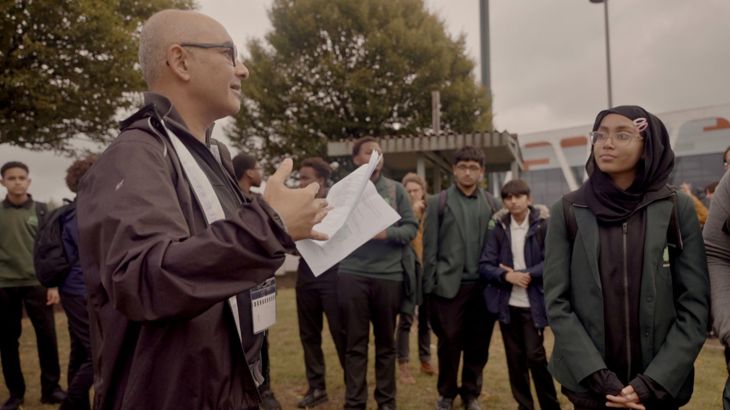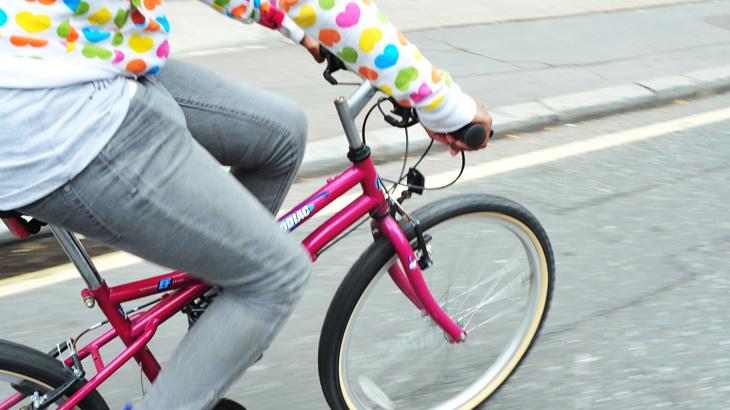The Hidden Engineering Behind Public Spaces, Art, and Play brought together engineers from some of London’s largest regeneration areas to design and deliver walking tours and activities for under-represented secondary school pupils in their areas.
Maha explains the Hidden Engineering project, run in partnership with the Royal Academy of Engineering. (53 seconds)
Shining a light on engineering
Ask young people what an engineer does, and you might get some blank looks.
Ask an engineer how to engage with young people, or the public at large, and you might get a similar response.
But if we want to make our neighbourhoods truly accessible, we must have greater understanding between the people that create these spaces and the people that live in them.
So our recent project in London brought together 20 engineers and 101 year 9 pupils for a shared learning experience, helping to break down these barriers.
We delivered training to the engineers, in the form of two full-day workshops. This equipped them to design a range of activities to engage the students from three local schools in the boroughs of Islington, Barking & Dagenham, and Hammersmith & Fulham.

A healthy street should be "sustainable, diverse and welcoming," according to one student. PHOTO: Roxanne Hackwood
Real world learning
The focus was on understanding topics such as highways, drainage structures and greening.
Engineers delivered interactive walking tours and workshops for the pupils, focusing on real-world sites designed by themselves, such as Fiddler’s Green in Barking and Wilton Villas in Islington.
These place-based activities sparked meaningful conversations about accessibility, sustainability, and community design.
From testing sustainable drainage systems with soil-filled bottles to navigating public spaces in wheelchairs, students got hands-on with engineering.
They got to explore the built environment in their own communities and carried out activities typical to engineering - like taking measurements of spatial elements.
In doing so, they discovered how engineering shapes the spaces they use every day.
Martina O’Malley, an engineer at Sustrans, was involved in delivering the initiative and said:
"This project is aiming to make students interested in possibly pursuing engineering as a career when they might not have done that already.
“It's also about inspiring engineers to engage with their local community because I feel like as engineers, that's not normally something that we really do.
“So, it's kind of like breaking that wall down between design and how people actually use a space through lived experience and incorporating that into the work that we do.”
Engineering meets education
The programme helped to upskill engineers, so they were more confident in sharing their work and engaging with a public audience.
It also opened up engineering to pupils from a diverse background, who were under-represented in this field.
Nearly nine out of ten pupils (88%) felt the project gave them a better understanding of how engineering improves our lives, and half were inspired to find out more about engineering as a career.
The project helped pupils to think again about the built environment and what can be done to make neighbourhoods more accessible and attractive places to live.
When asked to describe a healthy street in three words one pupil said:
“I think sustainable, diverse and welcoming would be my few words.”
One of the engineers that took part said:
“You could see that really got through to the kids in terms of redesigning Fiddler’s Green because they talked about a lot of the healthy street elements, and what stuff you could actually add to improve Fidder’s Green.”

Students looked at how their neighbourhoods could become healthier places to live in. PHOTO: J. Bewley
Partnership working
Although the project was delivered by Sustrans, it wouldn’t have been possible without funding from the Royal Academy of Engineering who provided support through their Ingenious scheme.
Our engineers came from a mixture of consultancies, development corporations and local councils; Islington Council, BeFirst, Project Centre, Aecom, Mott Mac Donald, Markides Associates, Useful Projects and Expedition Engineering.
The pupils came from the City of London Academy Islington, Greatfields School, and the Phoenix Academy.
Looking ahead
The project also provided us with learning opportunities which we will be able to take forward into future collaborations.
Students with additional needs were among the most engaged, especially during hands-on activities.
Female and non-binary students showed strong interest in engineering careers, often leading the design workshops.
Engineers gained confidence in public engagement, with 100% of surveyed participants finding the experience enjoyable.
75% of students said their understanding of “hidden engineering” improved significantly.
We invite you to take the next step towards meaningful youth engagement and inclusive engineering projects. Let's start a conversation about how we can work together to create positive change and amplify the voices of under-served people in our communities.
Contact us if you're interested in exploring how our team can support you.





